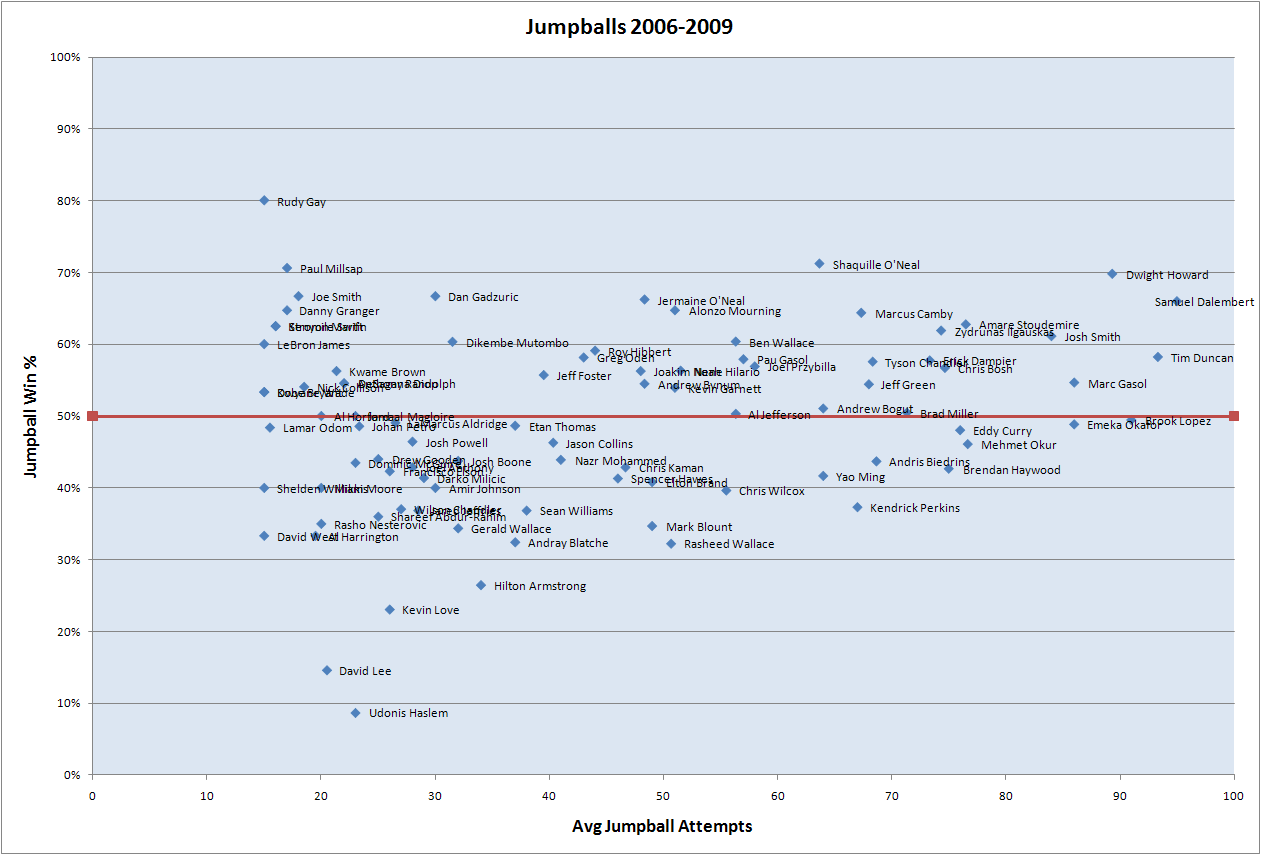Individual Jump Ball Performance
February 04 2010Thanks to play-by-play data from Basketball Geek, I’ve been messing around with the game logs for the three seasons from 2006-2009.
One of the things I’ve always been fascinated with is the jump ball. To my eyes, it obviously takes height and athleticism, but there is also the factor of tipping it into the right place. I remember watching a Spurs game from a few years ago (sorry, tried looking for the specific play but couldn’t find it) in which Tim Duncan won the opening tip by slapping it hard to Manu Ginobili, who gathered the ball and without breaking stride made a nearly uncontested layup. That play was probably drawn up by the Spurs because they knew they had the advantage in the jump ball.
First, some basics about the jump ball. There is one to start off every game to determine the initial possession. The winner of that jump ball will also start with possession in the 4th quarter, while the loser gets possession in the 2nd and 3rd quarters. Thus, the opening jump ball is really not that crucial to the game. A jump ball can also occur during the flow of the game, most often in the event of a tie-up for possession of the ball. A complete list of ways to initiate a jump ball can be found here.
Jump balls are also used to start each overtime period. This is a potentially huge advantage as there are very few possessions in the overtime period as it is, and winning the jumpball guarantees you will have at least as many possessions as your opponent. I may look at overtime jump ball stats and their correlation to winning games in the future.
So, are some players better at jump balls than others? I looked across the three seasons from 2006-2009 and kept track of each jump ball and determined the winner by seeing who ended up with possession. My criteria was that a player’s stats were only counted if, during the season, the player attempted at least 15 jump balls. This weeds out most of the smaller players who only do jump balls when they are part of a tie-up. I then looked at the average attempts per season and calculated their jump ball win percentage.
The chart has the average attempts on the x-axis and the win % on the y-axis. The best players for jump balls are the ones furthest up and furthest right. Although there is a slight positive trend (which tells us that NBA teams are, for the most part, picking the right players to do the jump balls), the results are pretty scattered.
The individual results are also not that surprising. Most people would probably have guessed that Dwight Howard is one of the most effective players at the jump ball. The “winners” of this survey are Howard, Duncan, Shaq, and Samuel Dalembert.
Also, it’s interesting to see how height isn’t necessarily the most important trait. In fact, although I have not done this analysis, it looks like rebound rate would be a good proxy for jump ball effectiveness. All the high % players are ones that are usually associated with good rebounding skills and the effort/desire to play in the low block. The ones that are low % but also made many attempts (Yao Ming, Mehmet Okur, Eddy Curry, etc.) are tall players but not necessarily athletic players.
However, height does matter in that it seems to serve as kind of a threshold stat. The three worst players in this survey are Kevin Love (ouch), David Lee, and Udonis Haslem. All three are undersized big men that had to play significant stretches as the lone big man (Love when Jefferson went down in 2009, Lee pretty much all the time, Haslem after Shaq was traded from the Heat). Even though all three players are effective rebounders, it looks like those skills don’t really help in their case as they do not meet a basic level of height.
Finally, I just want to mention that this is a relatively small sample size, as even in the best case (say, for Dwight Howard), we still only have about 250 attempts over the three-year period. Statistical fluctuations can and do occur. The next step is to see if winning the jump ball in overtime actually leads to an increased probability of winning the game.
comments powered by Disqus
